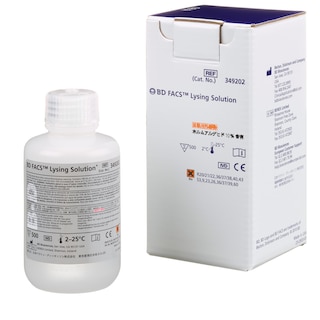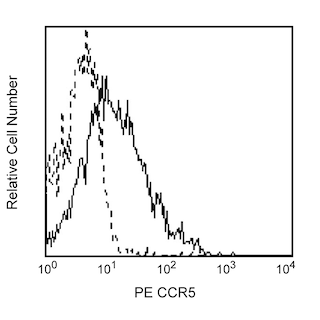-
Your selected country is
Middle East / Africa
- Change country/language
Old Browser
This page has been recently translated and is available in French now.
Looks like you're visiting us from {countryName}.
Would you like to stay on the current country site or be switched to your country?


.png)

Flow cytometric analysis of CD195 expression on human peripheral blood lymphocytes. Whole blood was stained with either PE Mouse IgG2a, κ Isotype Control (Cat. No. 555574; dashed line histogram) or PE Mouse Anti-Human CD195 (Cat. No. 556042/560932/550632; solid line histogram). Erythrocytes were lysed with BD FACS™ Lysing Solution (Cat. No. 349202). Fluorescent histograms were derived from gated events with the side and forward light-scatter characteristics of viable lymphocytes.
.png)

BD Pharmingen™ PE Mouse Anti-Human CD195
.png)
Regulatory Status Legend
Any use of products other than the permitted use without the express written authorization of Becton, Dickinson and Company is strictly prohibited.
Preparation And Storage
Recommended Assay Procedures
Immunophenotyping studies of chemokine receptors need to be performed on freshly collected whole blood (<24 Hrs). Incubation with the antibody should be done at room temperature in the dark. Cellular manipulation, such as Ficoll™ separation, freezing, or exposure to cold temperatures prior to staining have been shown to cause a decrease in staining intensity and inconsistent results.
Product Notices
- This reagent has been pre-diluted for use at the recommended Volume per Test. We typically use 1 × 10^6 cells in a 100-µl experimental sample (a test).
- An isotype control should be used at the same concentration as the antibody of interest.
- Caution: Sodium azide yields highly toxic hydrazoic acid under acidic conditions. Dilute azide compounds in running water before discarding to avoid accumulation of potentially explosive deposits in plumbing.
- Source of all serum proteins is from USDA inspected abattoirs located in the United States.
- For fluorochrome spectra and suitable instrument settings, please refer to our Multicolor Flow Cytometry web page at www.bdbiosciences.com/colors.
- Ficoll-Paque is a trademark of Amersham Biosciences Limited.
- Species cross-reactivity detected in product development may not have been confirmed on every format and/or application.
- Please refer to http://regdocs.bd.com to access safety data sheets (SDS).
- Please refer to www.bdbiosciences.com/us/s/resources for technical protocols.
Companion Products






The 3A9 monoclonal antibody recognizes CD195, which is also known as the chemokine receptor, CCR5, a seven transmembrane-spanning G protein-associated molecule. The 3A9 antibody also reportedly cross-reacts with human CCR8. Results of epitope mapping and sequence comparison between CCR5 and CCR8 reveals that the first three amino acid residues for these two receptors are identical: MDY (Met-Asp-Tyr). CCR5 belongs to the β-chemokine receptor family. It is expressed on subsets of T lymphocytes, NK cells, monocytes, macrophages, and dendritic cells. CCR5 regulates lymphocyte chemotaxis activation and transendothelial migration during inflammation. It signals a response to at least three chemokines: RANTES and macrophage inflammatory protein-1 (MIP-1) α and β. Additionally, CCR5 has been found to be a co-receptor for macrophage-tropic HIV-1 on CD4+ cells, a characteristic that is important in viral transmission. Reports indicate that individuals who have partial (heterozygous) or complete (homozygous) deletion of the CCR5 allele, demonstrate resistance to HIV infection. CCR5 has been clustered as CD195 in the VIIth HLDA workshop.

Development References (9)
-
Choe H, Farzan M, Sun Y, et al. The beta-chemokine receptors CCR3 and CCR5 facilitate infection by primary HIV-1 isolates. Cell. 1996; 85(7):1135-1148. (Biology). View Reference
-
Deng H, Liu R, Ellmeier W, et al. Identification of a major co-receptor for primary isolates of HIV-1. Nature. 1996; 381(6584):661-666. (Biology). View Reference
-
Doranz BJ, Rucker J, Yi Y, et al. A dual-tropic primary HIV-1 isolate that uses fusin and the beta-chemokine receptors CKR-5, CKR-3, and CKR-2b as fusion cofactors. Cell. 1996; 85(7):1149-1158. (Biology). View Reference
-
Dragic T, Litwin V, Allaway GP, et al. HIV-1 entry into CD4+ cells is mediated by the chemokine receptor CC-CKR-5. Nature. 1996; 381(6584):667-673. (Biology). View Reference
-
Hancock WW. Chemokines and the pathogenesis of T cell-dependent immune responses. Am J Pathol. 1996; 148(3):681-684. (Biology). View Reference
-
Mason D. David Mason .. et al., ed. Leucocyte typing VII : white cell differentiation antigens : proceedings of the Seventh International Workshop and Conference held in Harrogate, United Kingdom. Oxford: Oxford University Press; 2002.
-
Raport CJ, Gosling J, Schweickart VL, Gray PW, Charo IF. Molecular cloning and functional characterization of a novel human CC chemokine receptor (CCR5) for RANTES, MIP-1beta, and MIP-1alpha. J Biol Chem. 1996; 271(29):17161-17166. (Biology). View Reference
-
Rottman JB, Ganley KP, Williams K, Wu L, Mackay CR, Ringler DJ. Cellular localization of the chemokine receptor CCR5. Correlation to cellular targets of HIV-1 infection. Am J Pathol. 1997; 151(5):1341-1351. (Biology). View Reference
-
Wu L, Paxton WA, Kassam N, et al. CCR5 levels and expression pattern correlate with infectability by macrophage-tropic HIV-1, in vitro. J Exp Med. 1997; 185(9):1681-1689. (Biology). View Reference
Please refer to Support Documents for Quality Certificates
Global - Refer to manufacturer's instructions for use and related User Manuals and Technical data sheets before using this products as described
Comparisons, where applicable, are made against older BD Technology, manual methods or are general performance claims. Comparisons are not made against non-BD technologies, unless otherwise noted.
For Research Use Only. Not for use in diagnostic or therapeutic procedures.
Report a Site Issue
This form is intended to help us improve our website experience. For other support, please visit our Contact Us page.